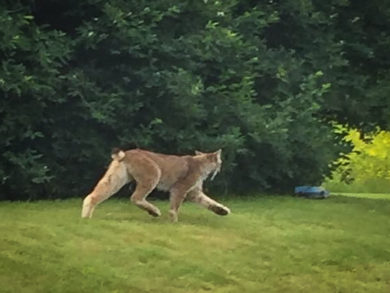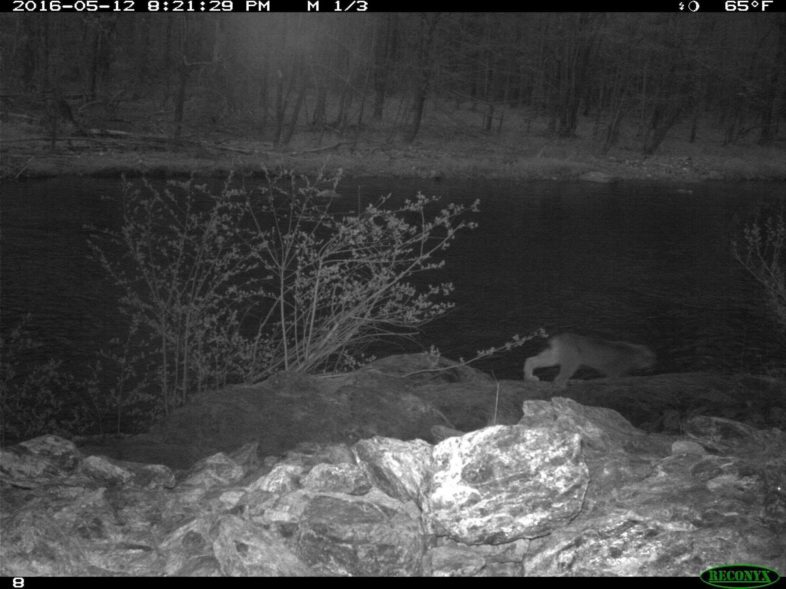
This state-endangered Canada lynx was photographed by a Londonderry resident in June, far across the state from the Northeast Kingdom regions in which lynx have previously been spotted. From Vermont Fish and Wildlife Dept.
A lone Canada lynx was photographed in the southern Vermont town of Londonderry this June, marking the first confirmed evidence of lynx in Vermont outside the Northeast Kingdom in decades. Lynx are listed as ‘threatened’ under the federal Endangered Species Act and ‘endangered’ in the state of Vermont.
The lynx was photographed in the back yard of a rural Londonderry home. Biologists with the Vermont Fish & Wildlife Department confirmed the identification of the animal from the photos and visited the site to confirm the location of the photos.
Since that time, a wildlife camera photo has emerged that biologists suspect is also of a lynx in nearby Searsburg, Vermont. The photo was taken in May shortly before the Londonderry sighting, but was only recently noticed by the University of Vermont student who had set the camera trap out as part of her wildlife research. The animal was photographed while it was passing under Route 9 using a wildlife underpass created in partnership with Vermont Fish & Wildlife and VTrans.

A suspected Lynx photographed with a game camera monitoring a wildlife underpass in Searsburg. Photo from Vermont Fish and Wildlife Dept.
“This was very exciting news for Vermont,” said Chris Bernier, a wildlife biologist for the Vermont Fish & Wildlife Department who is in charge of lynx conservation. “The fact that this animal chose to travel such a long distance demonstrates why it is vitally important to maintain healthy and well-connected habitat in Vermont. We were thrilled to see the animal using a wildlife underpass that was created for the express purpose of allowing animals to pass safely under the road.”
Male lynx are known to disperse long distances, so Bernier believes that there is a strong chance this may be the same lynx in both sightings. Biologists regularly monitor lynx habitat in the area and have not picked up other evidence of the animals locally, indicating that it is unlikely that lynx have established a resident population in southern Vermont. Lynx are strongly tied to large, unbroken forests of spruce and fir trees with high numbers of snowshoe hares, their primary prey species. Forests of this type are mostly found in Vermont in Essex County, and are less common elsewhere in the state.
The Vermont Fish & Wildlife Department actively monitors for lynx in the Nulhegan Basin of Conte National Wildlife Refuge and at the Bill Sladyk and Victory Basin Wildlife Management Areas in partnership with the U.S. Fish & Wildlife Service and Plum Creek Timber Co. Survey work in 2016 was unable to detect a resident population anywhere in Vermont despite increased survey efforts.
“Vermont has never had a large or stable lynx population. Records of lynx in Vermont were extremely rare even at the time of the earliest colonists, and have remained infrequent,” said Bernier. “We believe lynx may have dispersed into Vermont following a boom in Maine’s lynx population in the early 1990s. Maintaining appropriate habitat is vital to ensuring that lynx can exist in this state, even if only as transients.”
Source: Vermont Fish & Wildlife press release

Last winter I swore I heard a Lynx in the woods behind my house (near my chicken coop) after it had been dark for about an hour. I couldn’t see anything but eyes from where I was standing, but my dog sure was scared and I had never heard anything like it before. Did some research online and found that the sound (to me) sounded exactly like a Lynx. Would love to get a positive identification on that, I have a (not so great) recording.
Send it to us and we can have a listen and share it with experts too and see what they think.
Hi, if you send us the sound file and the details that go with it, we can get it to some experts in the state. Or, I email and we can give you contact so you can get in touch with them directly. Thanks, Kent
If this animal were to – God Forbid– end up killed by a trap meant for bobcats–does the owner then face charges for killing an endangered species?
You would have to discuss this with the Vermont Fish and Wildlife Dept, but from my understanding this would be an “incidental take” and not be an offense, unless it was shown that the person willfully was intending to do harm. There is a bunch of information on the VTFWD page about this: see http://www.vtfishandwildlife.com/hunt/furbearers_and_trapping/canada_lynx_or_bobcat_learn_the_difference to start.
I just saw a lynx in my yard in Vermont. It was amazingly large and looked in good health. This is about 10:00am in southern Vermont. Wow.
Jean
I forgot to say that it is January 16, 2022.
Today, May 18, 2022, I saw a lynx exactly this color enter the woods from the Hinesburg Road near the area of Ballou Mountain Road. (I was driving down the hill from Marlboro Vermont to Brattleboro on the Hinesburg Rd, which follows a wide stream that I believe is the Green River.) The lynx hesitated when it was about three feet into the woods on my left, and it looked over its shoulder at my car, as if to judge what direction my car was going, then it moved forward again in a determined and deliberate fashion, but not at all panicked. The lynx was in the sun, and it was clearly this color.
Lynx spotted in our backyard in Dummerston early this morning. Quite a thrill!
Just saw a tan lynx like this one crossing VT 16 in Wheelock, VT. Saw one once before about 15 years ago in St. Johnsbury.